This post may contain affiliate links. Please see our disclosure policy.
This quick and flavorful Mongolian beef and noodles recipe brings together tender beef, chewy rice noodles, and a bold, savory sauce — all in under 30 minutes. It’s one of our family favorites, and honestly, it’s better than your favorite take-out dish.
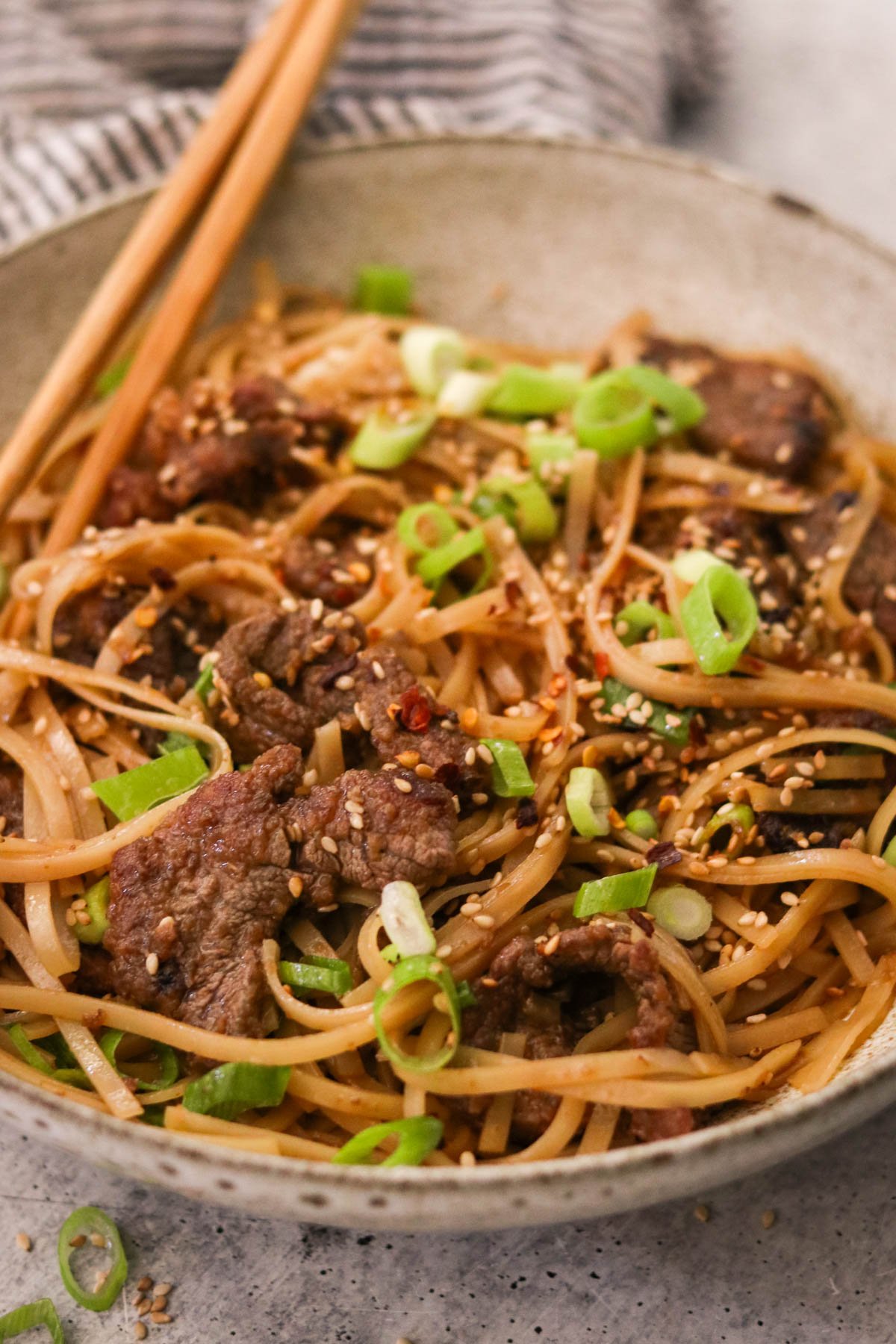
Why You’ll Love This Recipe
If you’ve ever craved the sweet-savory flavor of restaurant Mongolian beef, this homemade version will win you over in one bite. It’s made with real-food ingredients you can grab at any grocery store — no bottled sauces or mystery additives here. Plus, using rice noodles makes this naturally gluten-free.
If you enjoy this kind of flavor-packed bowl, you might also love my steamed pork buns or this Whole30 mongolian beef version with no added sugar.
What I love most is how adaptable it is. You can bulk it up with fresh veggies like green beans, mushrooms, or bell peppers, or keep it simple and serve it alongside my go-to smashed cucumber salad. Either way, it’s a weeknight dinner winner that my kids ask for again and again.
Ingredients You’ll Need
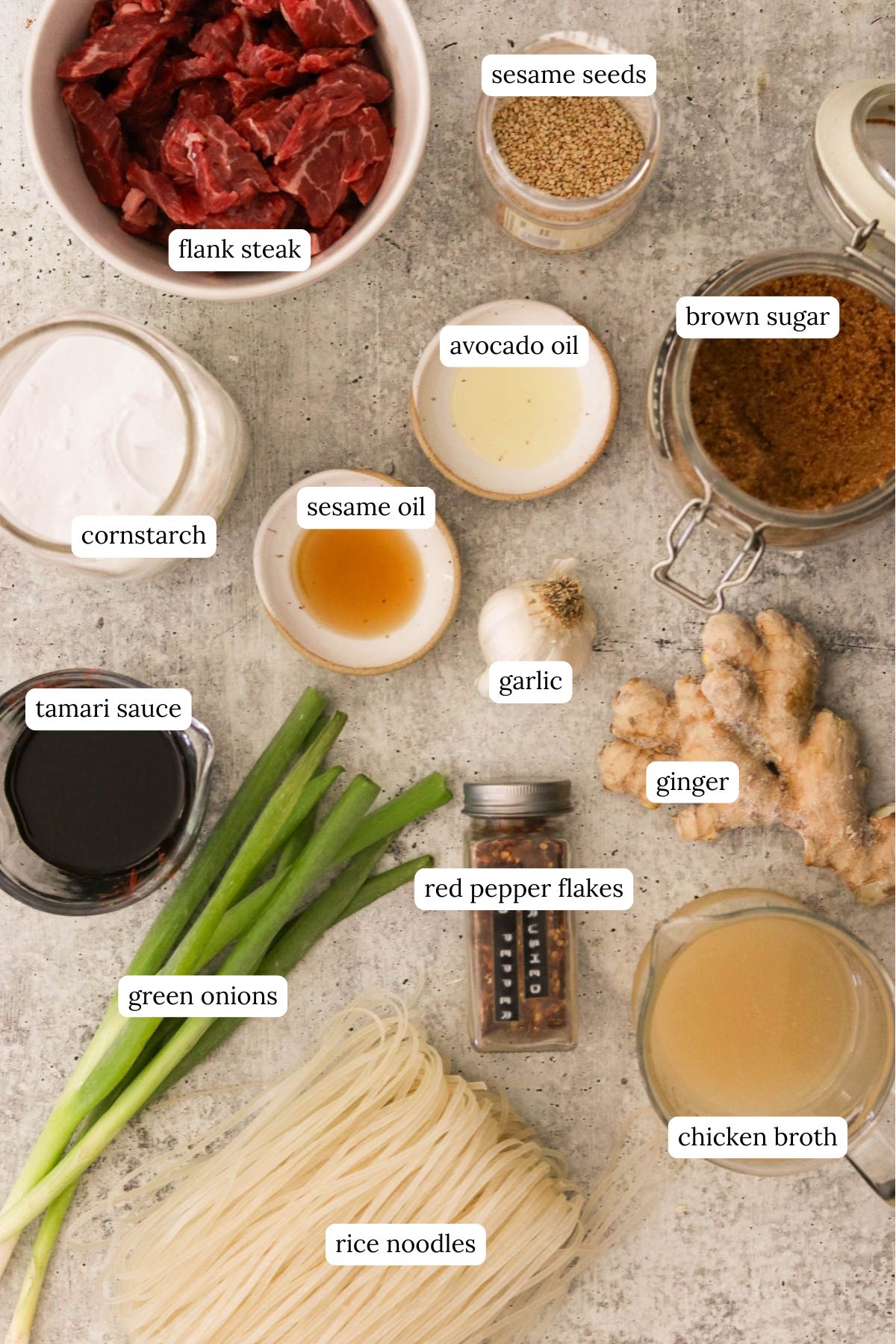
- Flank steak: Slice it thinly against the grain for tender beef with a nice sear.
- Cornstarch: Helps crisp up the beef and gives the sauce its signature glossy texture. Arrowroot works too for a grain-free option.
- Avocado oil: Great for high heat stir-frying in a large nonstick skillet.
- Sesame oil: Adds nutty depth to the sauce.
- Garlic and fresh ginger: These bring warmth, bite, and that classic stir fry flavor.
- Tamari or low sodium soy sauce: For a rich umami base; tamari keeps it gluten-free.
- Chicken broth or beef broth: Adds body and balances the salty and sweet.
- Brown sugar: Brings in the signature Mongolian sweetness — feel free to reduce slightly if preferred.
- Rice noodles: I love these for their texture and quick soak time, but any cooked noodles work here.
- Green onions, sesame seeds, crushed red pepper flakes: For garnish, crunch, and heat.
How to Make Mongolian Beef and Noodles
Making Chinese food at home may seem like a feat, but it’s actually quite simple (and forgiving!). All you need is a large skillet, fresh noodles, and these simple steps!
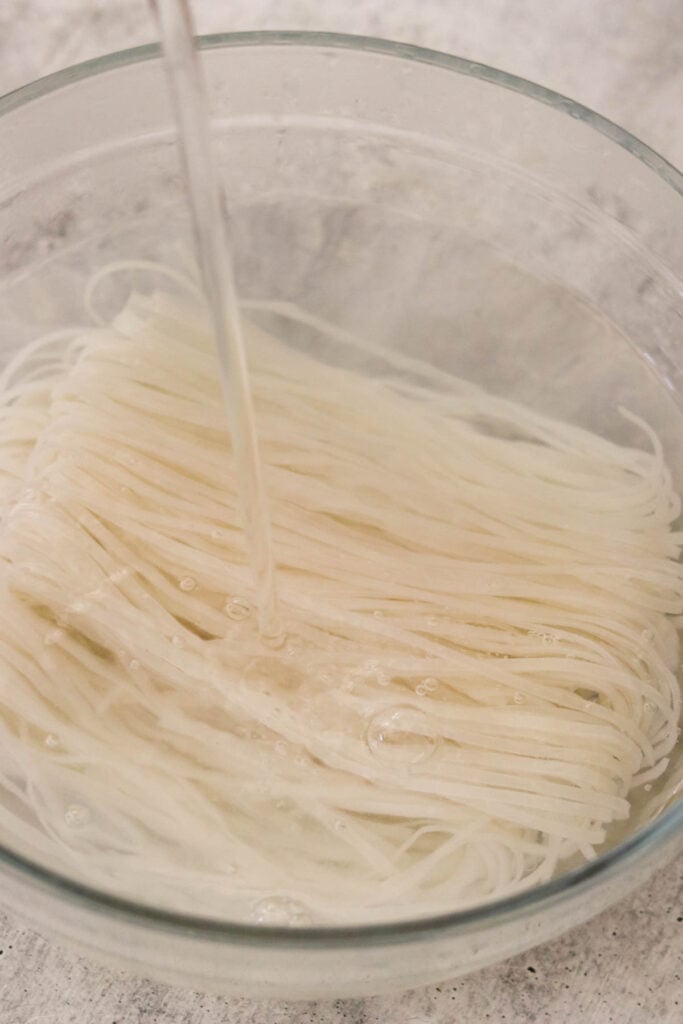
Step 1: Soak rice noodles in hot water for 10 minutes, then drain and rinse under cold water. If using another noodle, cook according to package instructions and set aside.
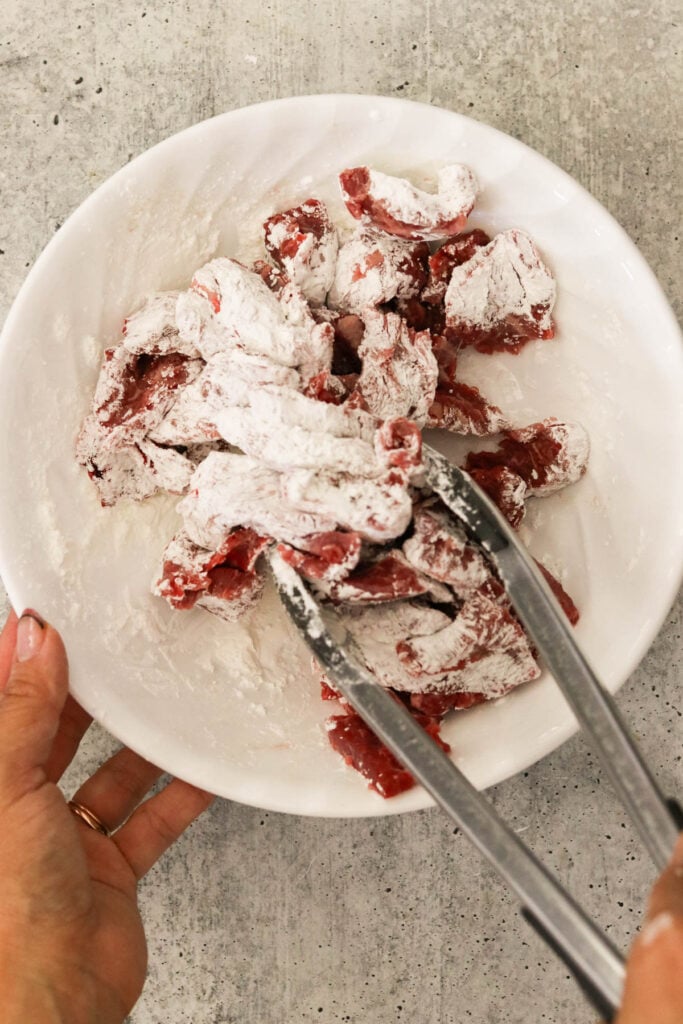
Step 2: Toss sliced flank steak in cornstarch to coat evenly.

Step 3: Heat avocado oil in a hot skillet over medium-high. Add the beef in a single layer and cook for 2 minutes per side until browned and crispy. Cook in batches if needed, adding more oil between rounds. Set aside.

Step 4: In the same skillet, heat sesame oil. Sauté garlic and ginger for 1 minute until fragrant.

Step 5: Pour in tamari, chicken broth, and brown sugar. Stir and bring to a boil. Reduce heat and simmer for 8–10 minutes until the flavorful sauce is slightly thickened. Return beef and cooked noodles to the pan, along with half the green onions. Stir until everything is warmed through.

Step 6: Serve hot, garnished with the remaining green onions, sesame seeds, and a pinch of black pepper or crushed red pepper if desired.
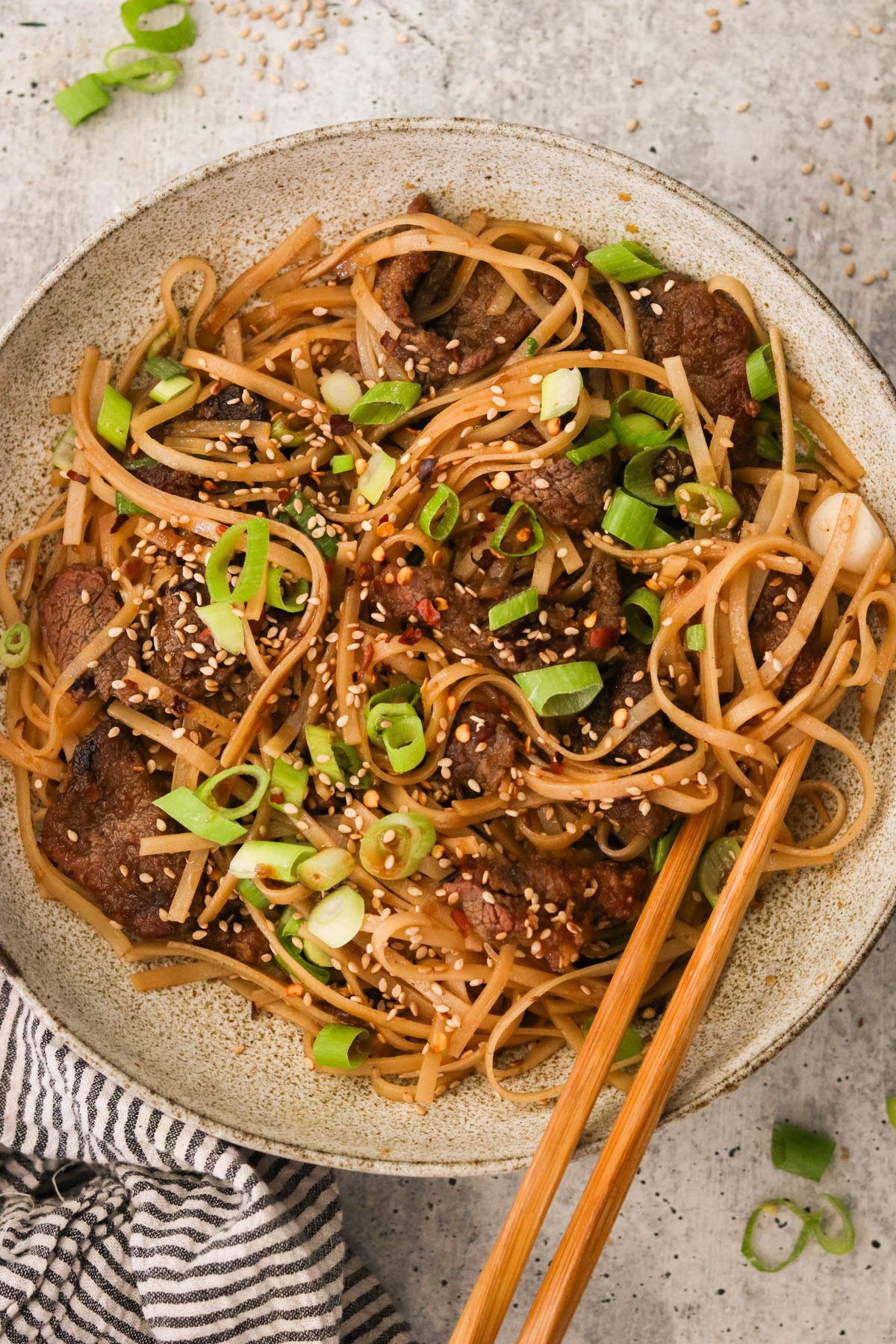
Recipe Tips
- Slice the beef thinly and evenly for best texture. Partially freezing the steak first can make slicing easier.
- Don’t overcrowd the pan. Cook in batches so the beef gets crispy, not steamed.
- Soak noodles just until pliable if using rice noodles. Over-soaking can lead to mushy texture.
- Make it veggie-forward: Stir in sautéed mushrooms, shredded carrots, or thinly sliced bell peppers.
- Batch it: Double the sauce and freeze half for a future weeknight dinner.
Want something similar but lower carb? Try my easy Asian Ground Beef and Cabbage Stir Fry next.
Storage Tips & Veggie Add-Ins
Leftovers store beautifully. Just pack them in an airtight container and refrigerate for up to 3 days. Reheat gently in a skillet with a splash of broth or water which is the best way to keep the noodles from drying out.
Want to boost the veggie content? Stir in sautéed green beans, thinly sliced carrots, mushrooms, or bell peppers with the noodles. The savory sauce coats everything beautifully and makes it all feel cohesive.
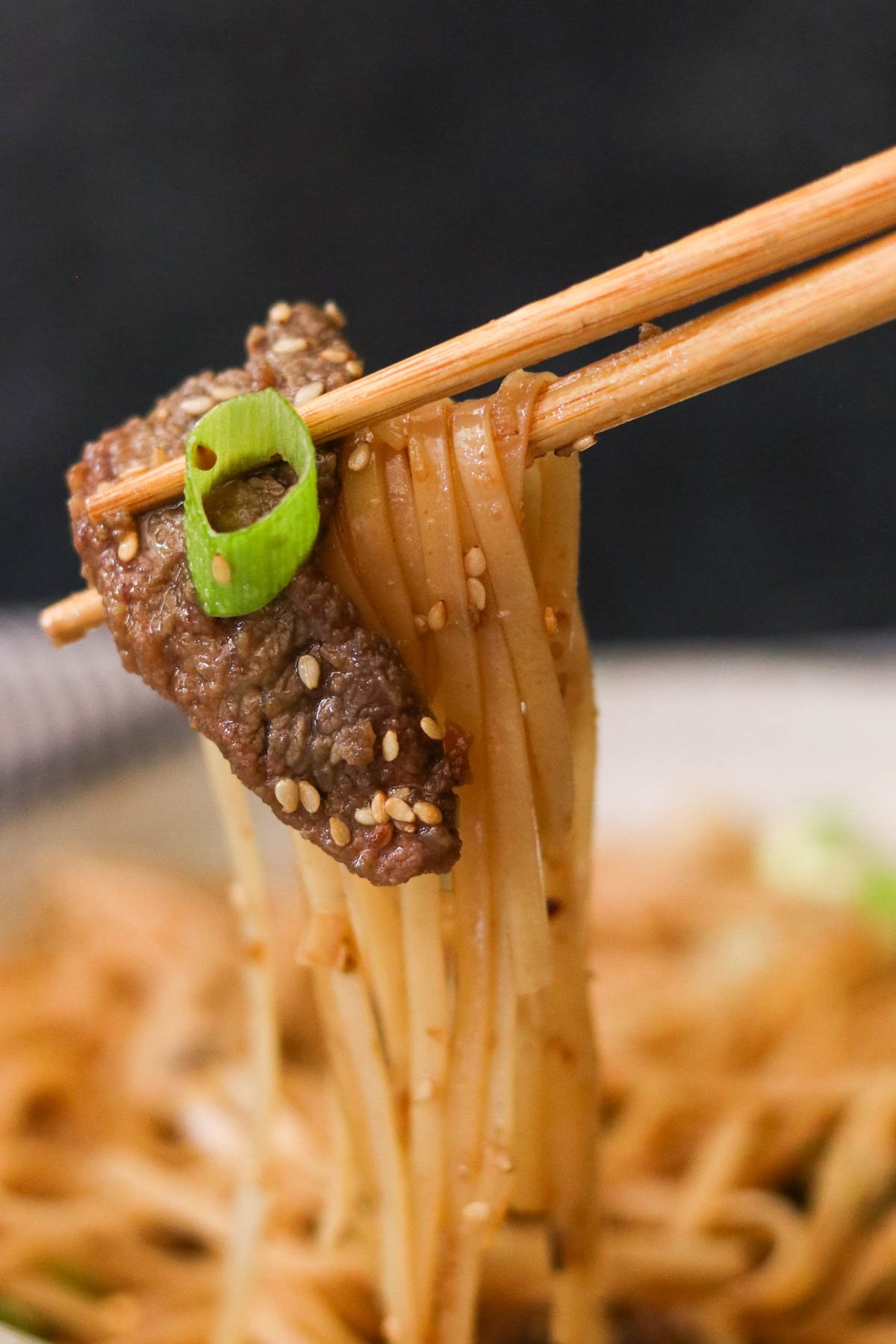
Recipe FAQs
Yes! Use tamari for gluten-free, and swap in coconut aminos and arrowroot starch for a paleo version. The flavor is still spot-on. For paleo, you can use these grain free noodles.
Rice noodles are my favorite — they’re naturally gluten-free and quick to cook (no boiling, just soak!). But ramen noodles, soba, or even spaghetti noodles can work.
Slice against the grain and don’t overcrowd the pan. A hot skillet is key to searing without steaming.
Absolutely. It’s one of our favorite take-out dishes to recreate at home. This homemade version is fresher, healthier, and just as craveable.
This quick, tasty Mongolian beef noodles recipe brings serious flavor with minimal effort. It’s a restaurant version you can feel good about serving on a busy weeknight — and trust me, it’s a family favorite you’ll be making again and again.
While you’re here, check out my Asian Daikon Noodles for another gluten-free takeout remake!
More Asian-Inspired Recipes
- Easy Beef Pepper Rice Recipe
- Instant Pot Korean Beef
- Slow Cooker Asian Beef Back Ribs
- One-Pot Asian Beef Stew
If you make this recipe, please leave me a star rating and comment below! I love to hear your thoughts and feedback. Follow me on social media Instagram, Facebook, and Pinterest for even more delicious recipes!
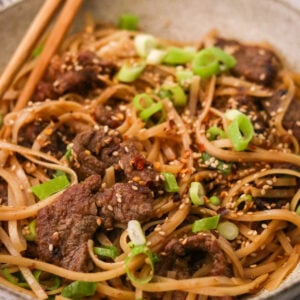
Easy Mongolian Beef Noodles in 30 Minutes
Video
Ingredients
- 8 oz rice noodles, or your favorite noodles
- 1 lb flank steak, sliced into bite-sized pieces
- 1/4 cup cornstarch, or arrowroot starch
- 2 tbsp avocado oil, or your favorite neutral oil – plus more, if needed
- 1 tbsp sesame oil
- 4 garlic cloves, minced
- 1 inch ginger, grated
- 1/2 cup tamari sauce , or soy sauce, if not gluten free
- 1 cup chicken broth
- 1/3 cup brown sugar
- 3 green onions, chopped
- Sesame seeds & crushed red pepper flakes, for garnish
Instructions
- Soak rice noodles in hot water for 10 minutes while you cook the meat. Make sure to drain and run under cold water once done soaking. If you are using another type of noodles, cook according package instructions and set aside.8 oz rice noodles
- Coat steak in cornstarch evenly in a bowl.1 lb flank steak, 1/4 cup cornstarch
- Heat avocado oil in large skillet over medium high heat. Add steak pieces in a single layer and pan fry for 2 minutes per side until browned and crispy. You may need to do this in 2-3 batches, add more oil as needed. Set aside the cooked meat.2 tbsp avocado oil
- Heat sesame oil in the skillet, then add garlic and ginger for 1 minute until fragrant.1 tbsp sesame oil, 4 garlic cloves, 1 inch ginger
- Add tamari sauce, chicken broth, and brown sugar. Stir to combine, then bring to a boil. Reduce heat to simmer for 8-10 minutes until reduced and slightly thickened.1/2 cup tamari sauce, 1 cup chicken broth, 1/3 cup brown sugar
- Stir beef and noodles, along with half of the green onions until warmed through. Remove from heat and serve topped with the remaining green onions, sesame seeds, and red pepper flakes, if using.Sesame seeds & crushed red pepper flakes
Notes
- Slice the beef thinly and evenly for best texture. Partially freezing the steak first can make slicing easier.
- Don’t overcrowd the pan. Cook in batches so the beef gets crispy, not steamed.
- Soak noodles just until pliable if using rice noodles. Over-soaking can lead to mushy texture.
- Make it veggie-forward: Stir in sautéed mushrooms, shredded carrots, or thinly sliced bell peppers.
- Batch it: Double the sauce and freeze half for a future weeknight dinner.
- Leftovers store beautifully. Just pack them in an airtight container and refrigerate for up to 3 days. Reheat gently in a skillet with a splash of broth or water which is the best way to keep the noodles from drying out.
Nutrition
Nutrition information is automatically calculated, so should only be used as an approximation.


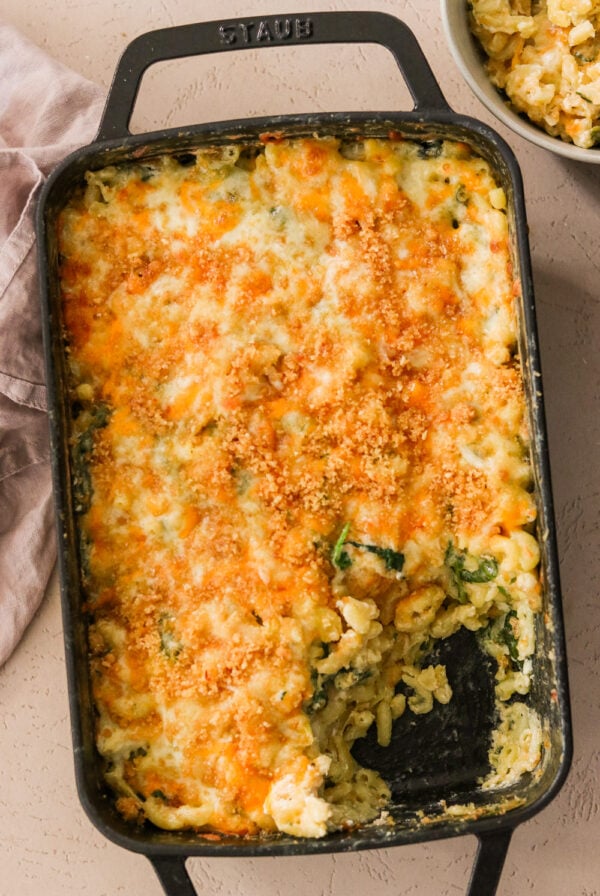
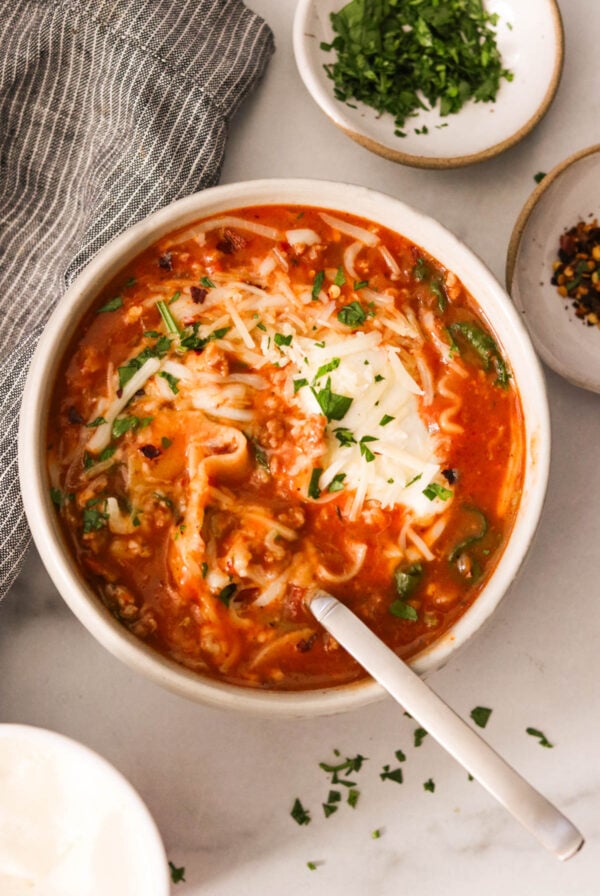
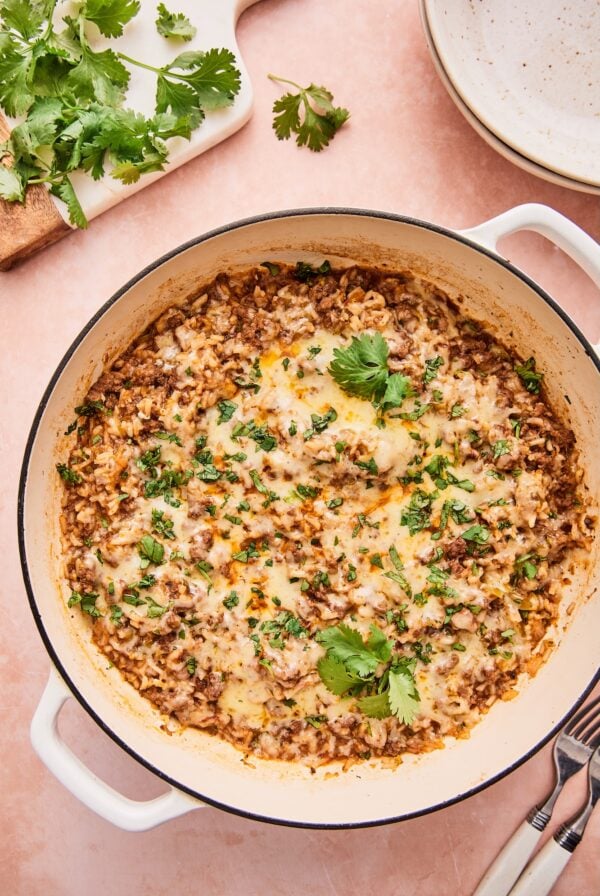
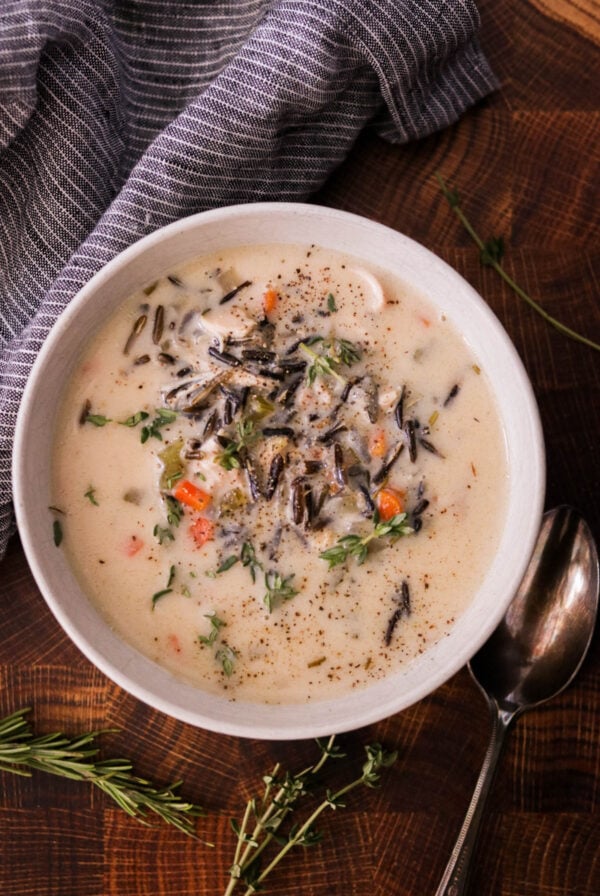
This was amazing! My husband loves a good Asian dish (and I’ve made a lot!) and when I made this we were both blown away! Thank you!
Yay! Thank you so much. 🙂
looks yummy can’t wait to try
Wonderful